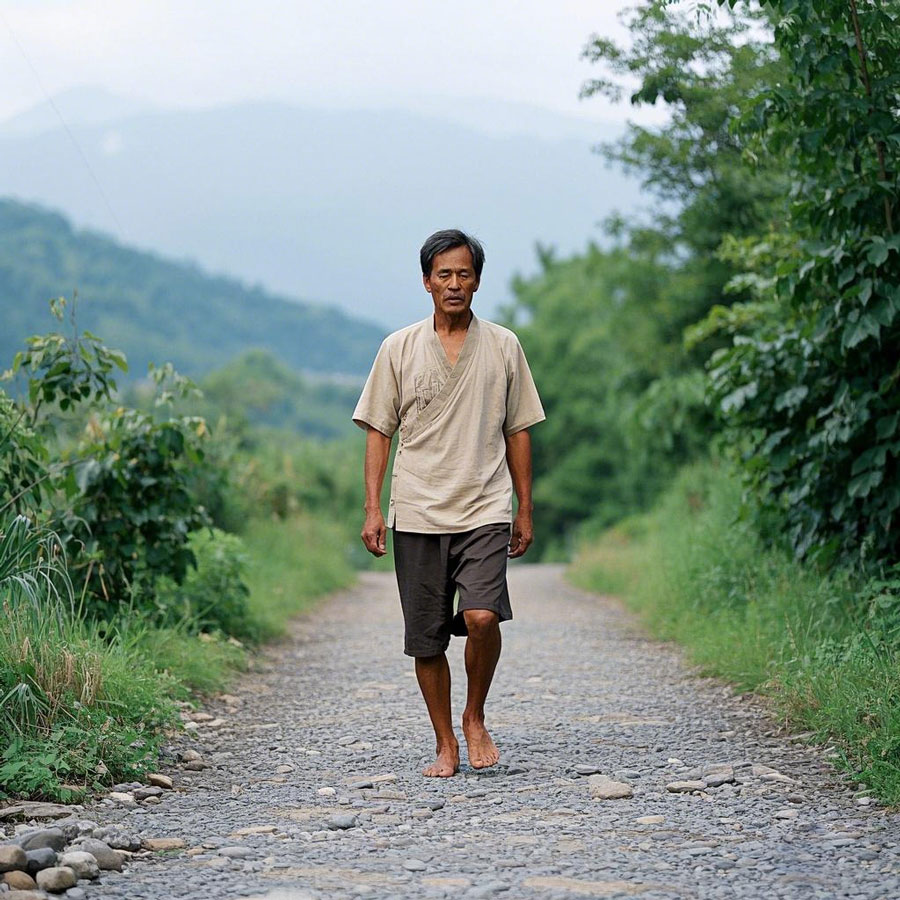Traditional Chinese Grounding Practice

The practice of walking barefoot on gravel paths in ancient China is closely related to traditional Chinese medicine (TCM) theory and health-preservation culture. This habit was not only a way of life but also a practice for health and wellness. Below is a detailed explanation of the reasons behind walking barefoot on gravel paths in ancient China, along with the cultural, medical, and philosophical context behind it:
1. TCM Theory and Foot Reflexology
Foot Reflexology Theory: In TCM, the feet are considered important convergence points for the body's meridians, closely connected to the internal organs. Stimulating specific acupoints on the feet can regulate the flow of qi and blood, thereby treating, preventing, and promoting health.
Stimulating Effect of Gravel Paths: Walking barefoot on gravel paths naturally massages the acupoints on the soles of the feet, stimulating the meridians and promoting the circulation of qi and blood, which improves overall health.
2. Health Preservation and "Connecting with Earth's Energy"
Concept of "Connecting with Earth's Energy": Ancient Chinese philosophy and health-preservation culture emphasize the harmony between humans and nature. Walking barefoot on the ground was seen as a way to "connect with Earth's energy," helping the body absorb the Earth's energy and balance yin and yang.
Embodiment of Natural Therapy: The ancients believed that the Earth possesses nourishing and healing powers. Walking barefoot allowed direct contact with nature, enabling the body to absorb the Earth's essence and strengthen physical health.
3. Physical Exercise and Strengthening the Body
Foot Exercise: Walking barefoot on gravel paths is a natural way to exercise the feet, strengthening the muscles and ligaments of the feet and improving blood circulation.
Promoting Overall Health: Stimulating the feet can indirectly affect the health of the entire body, particularly improving the digestive system, boosting immunity, and relieving fatigue.
4. Psychological and Mental Relaxation
Stress Relief: Walking barefoot on gravel paths not only benefits the body but also allows one to feel a close connection with nature, thereby relaxing the mind and relieving stress.
Meditation and Mindfulness: The ancients often combined barefoot walking with meditation and mindfulness, believing it could help people focus and achieve a state of unity between body and mind.
5. Cultural Customs and Traditions
Folk Customs: In some regions, walking barefoot on gravel paths became a folk custom, especially in the early morning or evening. People believed it could prevent illness and prolong life.
Influence of Taoism and Buddhism: Taoist and Buddhist practitioners often walked barefoot, viewing it as a way to reduce dependence on material things and achieve mental and spiritual cultivation.
6. Historical Records and Practical Examples
Ancient Medical Texts: Texts like the Yellow Emperor's Classic of Internal Medicine emphasize the importance of foot care, stating that "the feet are the root of the body." Regulating the feet can improve overall health.
Practices of Historical Figures: Many historical figures and health practitioners had the habit of walking barefoot. For example, the famous Tang Dynasty physician Sun Simiao advocated foot massage for health preservation.
7. Modern Scientific Explanations
Scientific Basis of Reflexology: Modern reflexology suggests that the nerve endings in the soles of the feet are connected to the body's organs. Stimulating the soles can regulate bodily functions.
Improving Blood Circulation: Walking barefoot on gravel paths promotes blood circulation in the feet, which in turn improves overall blood circulation.
Pain Relief: Stimulating the soles of the feet can promote the release of endorphins, helping to relieve pain and stress.
8. Practical Methods
Choosing a Gravel Path: Select a flat and clean gravel path, avoiding surfaces that are too sharp or uneven.
Duration and Frequency: Practice for 10-30 minutes daily, with morning and evening sessions being most effective.
Precautions: Beginners should start with shorter durations and gradually increase the time to avoid overexertion or injury to the feet.
Conclusion
The practice of walking barefoot on gravel paths in ancient China is a comprehensive embodiment of TCM theory, health-preservation culture, and philosophical thought. It is not only a method of health preservation but also a wisdom of harmonious coexistence between humans and nature. By walking barefoot on gravel paths, one can stimulate foot acupoints, promote the flow of qi and blood, strengthen the body, and relieve stress, thereby achieving physical and mental balance. This ancient health-preservation practice is still revered and practiced by many today.
